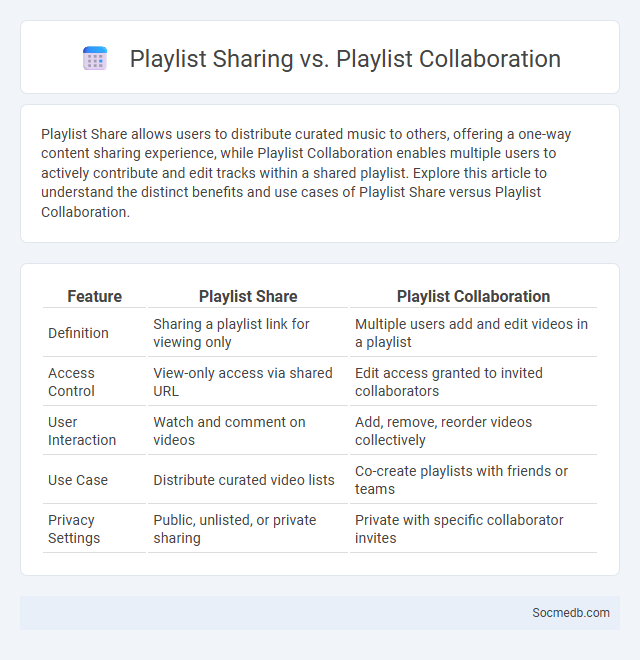
Photo illustration: Playlist Share vs Playlist Collaboration
Playlist Share allows users to distribute curated music to others, offering a one-way content sharing experience, while Playlist Collaboration enables multiple users to actively contribute and edit tracks within a shared playlist. Explore this article to understand the distinct benefits and use cases of Playlist Share versus Playlist Collaboration.
Table of Comparison
| Feature | Playlist Share | Playlist Collaboration |
|---|---|---|
| Definition | Sharing a playlist link for viewing only | Multiple users add and edit videos in a playlist |
| Access Control | View-only access via shared URL | Edit access granted to invited collaborators |
| User Interaction | Watch and comment on videos | Add, remove, reorder videos collectively |
| Use Case | Distribute curated video lists | Co-create playlists with friends or teams |
| Privacy Settings | Public, unlisted, or private sharing | Private with specific collaborator invites |
Understanding Playlists: Definitions and Types
Playlists on social media platforms are curated collections of audio, video, or multimedia content designed to enhance user engagement and personalization. Types of playlists include algorithmic playlists, which are generated based on user behavior and preferences, and editorial playlists, curated by platform experts or influencers to highlight trending or thematic content. Understanding these playlists enables brands and creators to optimize content distribution, target specific audiences, and maximize reach within social networks.
What is Playlist Sharing?
Playlist sharing is the process of distributing curated lists of songs or videos across social media platforms, allowing users to discover and enjoy personalized content from friends, influencers, or brands. This interactive feature enhances user engagement by enabling seamless collaboration, feedback, and social interaction around shared music or media interests. Platforms like Spotify, YouTube, and Apple Music integrate playlist sharing to boost content visibility and foster community-driven experiences.
Exploring Playlist Collaboration
Playlist collaboration on social media platforms like Spotify and Apple Music enables users to create, share, and edit music collections collectively, enhancing community engagement and personalized listening experiences. Tools such as collaborative playlists support real-time updates and seamless integration with social sharing features, driving higher user interaction and retention. Leveraging playlist collaboration fosters organic content discovery, amplifies music promotion, and cultivates social connectivity among diverse audience segments.
Key Differences: Playlist Share vs Playlist Collaboration
Playlist Share allows you to distribute a fixed set of songs to your followers or friends without altering the content, ensuring your curated music remains intact. Playlist Collaboration enables multiple users to add, remove, or reorder tracks within a shared playlist, fostering a collective and dynamic music experience. Your choice depends on whether you want to maintain control over the playlist or encourage interactive contributions from others.
Advantages of Sharing Playlists
Sharing playlists on social media enhances user engagement by allowing seamless music discovery and personalized recommendations, fostering a sense of community among listeners. Playlists serve as tools for expression, enabling users to showcase their musical tastes and connect with like-minded individuals across diverse platforms. Moreover, shared playlists drive traffic to streaming services, boosting artist exposure and supporting the digital music economy.
Benefits of Collaborative Playlists
Collaborative playlists enhance social media engagement by enabling users to co-create music collections, fostering community interaction and shared experiences across platforms such as Spotify and YouTube Music. These playlists increase content diversity and user retention by allowing multiple contributors to add, edit, or reorder tracks in real-time, enriching the social listening experience. Brands and influencers leverage collaborative playlists to boost audience participation, expand reach, and generate user-driven content that strengthens digital marketing strategies.
Platform Support: Where to Share and Collaborate
Social media platform support varies widely, with leading networks like Facebook, Instagram, LinkedIn, Twitter, and TikTok offering unique features for sharing and collaboration. Facebook supports extensive group interactions and event planning, while LinkedIn excels in professional networking and content sharing among industry peers. Collaborative tools such as shared documents, live streaming, and real-time chat integrations are increasingly common, enhancing user engagement and team communication across platforms.
Privacy and Control in Playlist Management
Managing your playlist on social media platforms demands enhanced privacy settings and granular control to safeguard personal preferences and data. Implementing features such as customizable sharing options, permissions for followers, and encrypted playlist data ensures your content remains secure and accessible only to intended audiences. Prioritizing these privacy controls empowers you to maintain ownership and protect your digital footprint effectively.
Real-World Use Cases: Share vs Collaborate
Social media platforms enable businesses to share content widely, increasing brand awareness and customer engagement through targeted posts and advertisements. Collaborative features such as group chats, shared documents, and real-time project boards foster teamwork, streamline communication, and enhance productivity within organizations. You can leverage these tools to balance broadcasting your message and building interactive, cooperative environments for your audience.
Choosing the Right Method for Your Playlist Needs
Selecting the ideal method for creating and managing your playlist depends on factors such as platform compatibility, user interface, and integration with social media channels like Instagram, TikTok, and Facebook. Leveraging tools with built-in sharing options and algorithm-driven recommendations enhances audience engagement and content discovery. Prioritizing features like collaborative editing and cross-platform syncing ensures a seamless experience tailored to diverse social media strategies.
 socmedb.com
socmedb.com